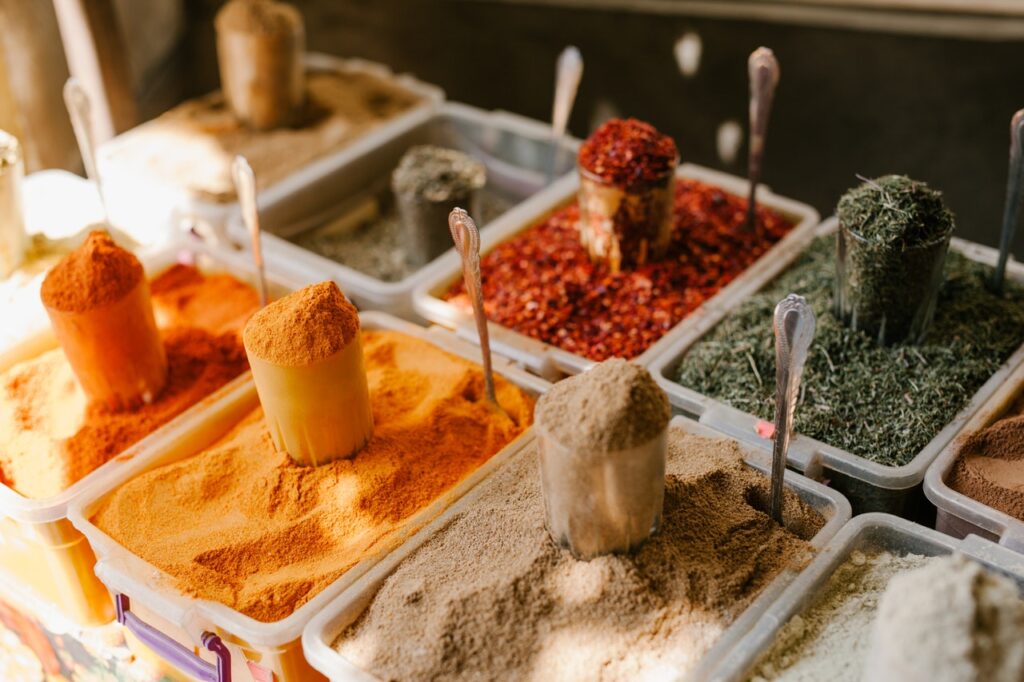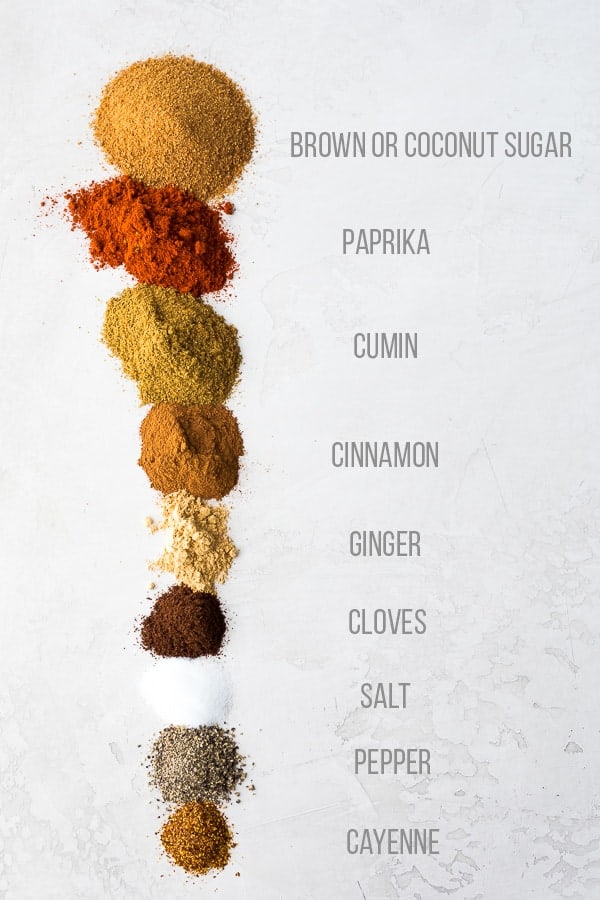Homemade Moroccan spices and herbs blend is the perfect way to add a little kick to your chicken, potatoes or vegetables! Great for sheet pan or grilling. Vegan, gluten-free, clean eating and paleo-compliant.
The layered flavors of Moroccan cuisine typically take hours to develop; think of the famous tagines or b’steela, a savory pie made with saffron-spiced chicken (or pigeon) and sugared almonds. Spices play a big role in that layering, and you’d be hard-pressed to find a Moroccan dish that doesn’t include a good measure of them. We talked to the experts at the Spice House, a purveyor of spices, herbs, blends, and extracts, to find out which are the essential for Moroccan food.

Ras el Hanout
This must-have spice mix in the Moroccan canon typically consists of more than a dozen ingredients. Among the more popular ones are cardamom, cumin, cloves, cinnamon, nutmeg, mace, allspice, dry ginger, chili peppers, coriander seed, peppercorn, sweet and hot paprika, fenugreek, and turmeric. Cooks use it on poultry, fish, vegetables and couscous.
Turmeric
Golden in color, with a mustard-like taste, turmeric adds an earthy and mildly astringent flavor. Its pleasant heat also adds color to tagines.
Cinnamon
With its assertive flavor and spicy heat, cinnamon is a key player in the Moroccan kitchen. Sri Lankan cinnamon has a delicate and floral taste and is ideal with meats and dried fruits in slow-cooked tagines.
Ginger
Dried and ground ginger has an unmistakable zing and a slightly sweet flavor. You’ll find it in tagines and couscous.
Saffron
Yes, saffron’s expensive, but the pros at the Spice House say it’s worth it—and that if you find a cheap version, it’s probably not really saffron. Unlike most other spices, saffron threads will last for years if stored in a dark pantry, and they add an unmistakable golden color to many classic Moroccan dishes including Couscous Royale. Moreover, taking a pinch of unbroken threads and lightly crushing them in your hands into a small amount of hot liquid is “culinary romance not to be missed.”
Paprika
There are many types of paprika on the market; for Moroccan cooking, unsmoked paprika of any origin will work. Its deep character and mild sweetness is especially nice in dishes that also feature tomatoes or eggplant.

One of my all-time favorite ways to add more flavor to my meal prep routine without adding a ton of calories is to mix it up with a spice blend.
I have an awesome collection of homemade spice blends (you can check them out in this post with 7 Dry Rub Recipes), and this homemade Moroccan spice blend is finally getting its own post!
This spice blend is soooo good…its savory, a bit sweet, and has the distinctive flavors of Morocco. Cinnamon, ginger and cumin give it such a cool flavor profile!
In addition, the best part of this homemade Moroccan spice blend is that you can customize the heat. I have had problems in the past with store-bought Moroccan spice blends that were waaaay too spicy for me. All I got was so much heat that I could not even taste the flavors.
How To Make Homemade Moroccan spices and herbs Blend
Making your own spice blends is so easy, and I bet you already have all of these ingredients in your pantry! All you need to do is mix them up and store them in an airtight container for up to a year.
Let us discuss the spices in this blend:
- Paprika & cumin- these spices form the flavorful base of the spice blend.
- Brown or coconut sugar- brings a subtle sweetness that helps balance out the other flavors.
- Cinnamon, ginger, cloves- bring the Moroccan flavors to the spice blend.
- Salt & pepper– essential for bringing all the other flavors to life.
- Cayenne- bringing the heat! Moroccan food is spicy, but I need to tone it down a bit for my family and me. Feel free to up the cayenne to your taste level
How To Use This Homemade Moroccan Spice Blend Recipe?
There are so many delicious ways to use this seasoning! It pairs particularly well with a bit of lemon, so make sure to add a bit to your recipes if possible.
- Chicken- we love this Moroccan spice blend on chicken, particularly thighs. Toss the chicken in a little olive oil, sprinkle on around 2 tablespoon of the seasoning per pound of chicken thighs, and bake or grill. Serve with lemony couscous!
- Cauliflower- SO freaking good on roasted or grilled cauliflower. We toss in olive oil, add the Greek seasoning blend, and roast up for 25-45 min (will depend on the size of your taters) at 425°F. Squeeze on some lemon juice just before serving!
- Ribs- OK I’m totally guessing but I have a feeling this Moroccan spice blend would taste amazing on a rack of ribs. Let me know if you try it!
- roasted chickpeas- I haven’t tried this either, but I would toss the chickpeas in 1 tablespoon of the Moroccan spice blend and roast up at 400°F for 30-45 minutes, until crispy.
How much of this homemade Moroccan spice blend do I use per pound of meat?
I roughly 2 tablespoons per pound. You want to use this seasoning aggressively, and it might look like too much. Don’t forget to pair your protein with something lemony flavored…even adding in some lemon wedges during baking or grilling can help.
What are some other ways I can use this Moroccan spice blend recipe?
- Add some olive oil and lemon juice and use it as a marinade (I would add 1 tablespoon olive oil, 1 teaspoon lemon juice and 1 tablespoon Moroccan seasoning per boneless skinless chicken breast)
- Add it to the cooking liquid for your rice or quinoa to give it some pizzaz (I would add 1 tablespoon per 1 cup uncooked rice or quinoa)
- Add it to your hummus or even to a yogurt based dip for a new flavor combo.
For more information Contact Us
